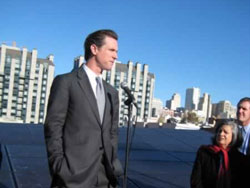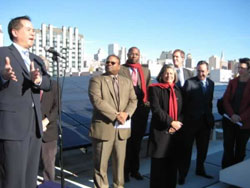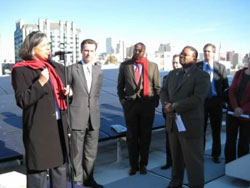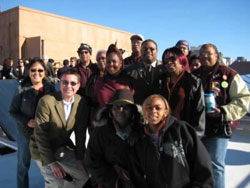|
By Phil Ting and David Hochschild Tuesday, December 11, 2007
|
San Francisco is setting the bar nationally and internationally for what cities can do to address global warming. We are tackling climate change head-on and have made incredible progress in recycling, smart growth and mass transit. But there is a glaring hole in our environmental policies: we have done almost nothing in renewable energy production. |
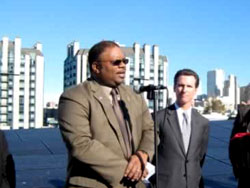 |
To date, the city only has five megawatts of solar power installed (total electricity demand is about 950 megawatts). Among Bay Area counties, San Francisco ranks last in terms of solar energy installed per capita. Meanwhile, preparations are under way to build four new "peaker plants" that run on fossil fuel, which are expected to generate as many as 180 megawatts of power to meet rising peak energy demand. |
In light of the city's recent efforts to address these peak energy needs, we propose something both radical and practical: |
|
The city should leverage its funds to put solar on every rooftop in San Francisco. In 2001, San Francisco adopted a goal of 10,000 solar roofs by 2010, yet to date we only have 600 rooftop solar energy systems installed. |
It is time to get serious about our investment in renewable energy by creating a world-class solar incentive program to help San Francisco residents and businesses go solar. |
The San Francisco Solar Task Force - a consortium of labor, governmental, environmental, business and solar energy organizations - has focused on accelerating the pace of solar energy installations in the city. We have already made great strides, including working with the Department of Building Inspection to implement a new fast-track permitting process for all solar energy systems in San Francisco. This past summer, the Task Force also worked with the Department of the Environment to launch www.sf.solarmap.org, an innovative solar mapping Web portal that provides tools to determine the solar potential of each property in the city. |
But for many, the biggest obstacle to going solar is cost. The average residential rooftop solar installation in San Francisco is about 2 kilowatts, which costs approximately $20,000. If we intend to meet the clean energy goals that we set for ourselves, we must make solar installation more affordable. |
To address this issue, the Solar Task Force has crafted a proposal to create the largest urban solar incentive program in the United States. The solution is a city-sponsored financial incentive program that will make up-front payments to residential and commercial property owners who install solar panels. A municipal incentive payment, when combined with state and federal rebates, will help cut the cost of going solar by almost in half. This incentive model has been implemented at the state level and has led to the installation of more than 32,000 rooftop solar energy systems throughout California. We believe that the addition of the city's incentive will make going solar more affordable while producing clean energy during the time of day when the dirtiest and most expensive power plants would otherwise be turned on. |
Finally, if we are to reach our goal of 10,000 solar roofs, we must begin to build public awareness around the many benefits of going solar. As part of the financial incentive program, the Task Force is recommending that the city invest in a full-scale marketing campaign to educate San Franciscans about the type and size of the solar system that best meets their energy needs, the energy efficiency steps that should be taken before going solar, and where to find local installers. San Franciscans also need to be better informed of the long-term financial benefits of going solar - for example, in addition to bringing monthly energy bills to zero, solar rooftops also pay for themselves in terms of the value they add to the property. A recent solar appraisal report showed that every $1,000 of energy savings generates an additional $20,000 in property value. |
To meet our growing energy needs, we must make clean energy production truly accessible to every San Franciscan. A world-class local solar incentive program, combined with bureaucratic ease and educational efforts, will allow us to jump-start renewable energy production and make San Francisco a national leader in clean energy. Only then will we fill the hole in San Francisco's environmental policies. |
|
Phil Ting is San Francisco's assessor-recorder. David Hochschild is a commissioner with the San Francisco Public Utilities Commission and Vice President of Solaria, a solar energy manufacturer based in Silicon Valley. |
|


